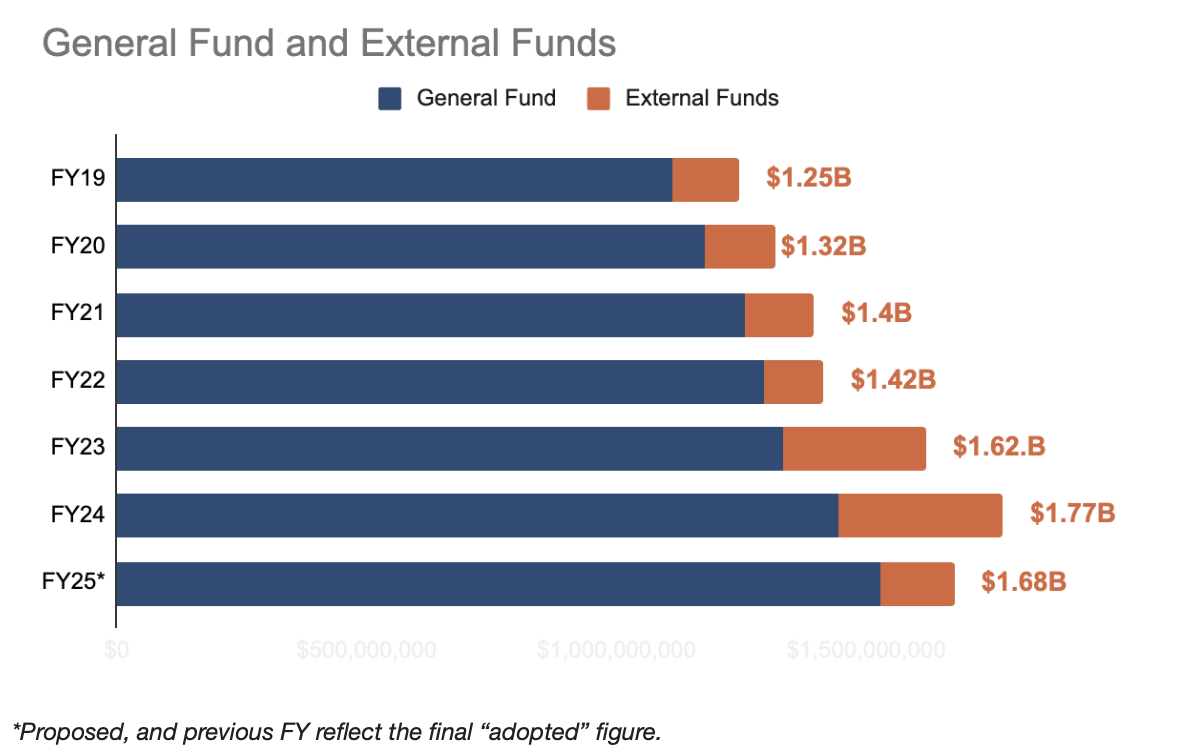FYI from BSF, 2.9.24
The draft Boston Public School (BPS) budget was presented at School Committee on Wednesday.
This kicks off a +5 month process of hearings, updates, and revisions. But, most of the time, it ends where it starts. The foundational aspects of the budget are evident in its first draft.
1. There are consistent priorities.
As in year’s past, BPS released a list of targeted investments. Inclusion and the transition of programs from federal pandemic dollars (“ESSER”) are two dominant themes (slides 9-20).
2. There is less money.
This was expected.
Like all public school budgets, Boston schools are funded through a combination of local revenue and “external funds” - federal funding, state funding, grants, etc.
ESSER is coming to an end, so a steep drop in external dollars means the total budget of BPS year over year declined by nearly $100M (page 16).
3. But there is more money.
That is because of the other pot of money available: money from the city of Boston (also known as the “general fund”). An additional ~$81M came in from the city to cover increasing expenses and the loss of federal funds.
The city is planning to appropriate ~$414M more to the school department than it did six years ago.
4. There is less staff.
Many positions funded through ESSER will be eliminated, or were never filled, resulting in a net loss of 339 staff members (page 16).
5. But there is more staff.
Tracing back from before the pandemic, there are nearly 2,000 more staff members at BPS.
Inflation is certainly creating cost pressures. But the addition of the staff is responsible for ~70% of increased spending over the past six years.
Staffing costs are growing at a faster rate than the increased investment of the general fund, which actually picked up the tab for 221 more staff members this year (page 3).
6. There are less students.
BPS has announced it is transitioning away from enrollment as the basis of budgeting. In light of that, there is no comprehensive enrollment analysis or projections as in years past, aside from an estimate of “100-150 less” provided by BPS staff during the School Committee presentation.
Absent a precise number, the trends are clear.
Costs are up, staff is up, enrollment is down.
The result? More than 3 of 4 BPS schools required additional funding (pages 2-4) to sustain their staff and programs because their schools were under enrolled. This is why, despite ~5% increase in the general fund, schools testified during public comment about their budget cuts.
The cost of empty seats actually declined this year, as the district consolidated classrooms and closed/merged the UP campuses.
Without revenue or expenses explicitly tied to enrollment, it is unclear whether the cost of empty seats will be addressed or just accepted, presuming the money is there.
Boston, like districts all over the country, is attempting to create its own soft landing by maintaining some ESSER investments and sunsetting others.
Absent any major changes to how a district functions, there is only way to successfully "land" this year and in the future.
A lot more local revenue.
notes in the margin
Full materials here for Wednesday’s School Committee meeting.
One of the first charter schools to open in Massachusetts - City on a Hill in Roxbury - will close at the end of next school year.
After an event in Randolph touting evidence-based reading and Governor Healey’s Literacy Launch, the joint committee on education released a bill that will give the Commonwealth more oversight over literacy curriculum and instruction.
A new report shows the Massachusetts educator workforce is becoming more diverse, but not keeping pace the demographics of students.
School violence: “kids these days” or something more? Safety issues raised in Medway, Brockton, and Framingham.
The conclusion of the Newton teacher strike yielded a new contract and plenty of takes (like this one). Legalization of teachers strikes won’t happen this legislative session.
National public school enrollment is slightly up, but not back to pre-pandemic levels. From Boston to St. Paul, part of this slide is being stemmed by newcomers.
It is not the school buses causing traffic in the mornings and afternoons. It is cars, as more and more kids get a ride instead.
One of the most significant investments of ESSER dollars - tutoring - may be the hardest to sustain.
The faulty FAFSA rollout may have real consequences for families - FAFSA submissions are down by more than half.
Dartmouth College has changed course and is reinstating the use of the SAT in admissions. Why? An analysis by the college indicated that disadvantaged students actually had a better chance of being admitted with an SAT score.
other matters
Priority registration for BPS ends today.











